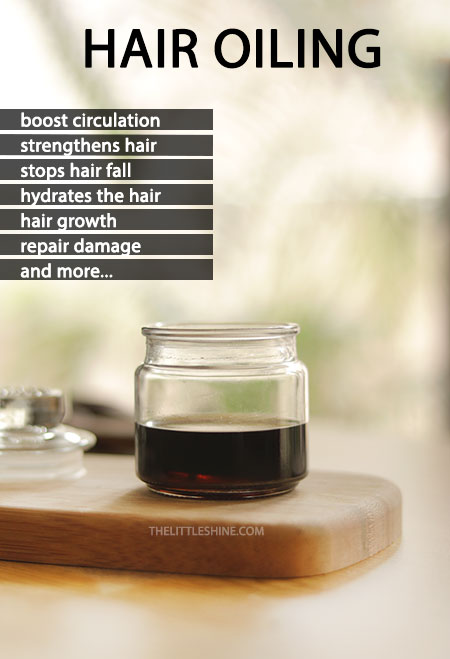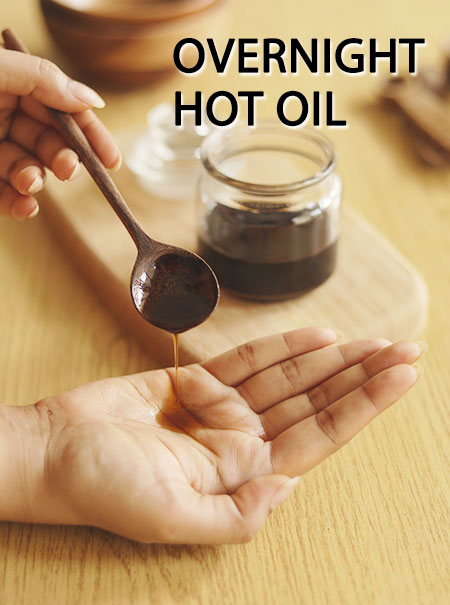Oiling of hair is a practice followed since ages. It involves pouring of oil onto the scalp and hair in order to improve the blood circulation of the scalp, to increase hair growth by stimulating the hair follicles, improve hair texture and lustre, decrease hair loss and make the hair look shiny and smooth. But apart from all these benefits, who wouldn’t like a lovely head massage that comes with oiling the hair, right?

Benefits of oiling hair:
Our hair is exposed all the time and can get dry, damaged and lose its lustre and shine over time because of over exposure to sunlight, ultra-violet (UV) damage, pollution, improper hair care routines, regular use of hair styling products etc. Therefore, oiling your hair can be beneficial to save the hair from damage and promote hair repair and hair growth over time. It can provide relief from stress, promote hair strength, prevent hair fall and keep the scalp hydrated.
What are the types of oil to be used for oiling of hair?
There is a plethora of oils available in the market and a whole range of oils that can be even made by ourselves at home. The question then is, “Which one should I use? Which one is the right one for me?”.
Natural oils like coconut oil, olive oil, almond oil, jojoba oil, argan oil, black seed oil etc., are carrier oils which can be used directly onto the scalp and hair and can also be used to dilute essential oils, which cannot be used directly onto the scalp and hair as they are very concentrated.
When diluting any essential oils into carrier oils – use around 10 to 12 drops of essential oil, with 6 to 8 teaspoons of carrier oils.
Caution: Most oils do not cause any irritation or allergic reactions, but it is essential to do a patch test before using any oils or oil blends. You can apply a little oil on your wrist or just below the ear and leave on for 12 to 24 hours to check for any reactions. Rinse off with water immediately if there are any reactions and discontinue its usage with immediate effect.
READ MORE – 2 BEST HERBS to stop hair fall and treat thinning hair

What’s the right way to oil your hair?
Here are a few steps to be followed when oiling your hair:
Step 1: Choice of oil
Choose the carrier oil you want to use and you can also add in a few drops of essential oil into the carrier oil.
Step 2: Warm up the oil
Warm up the oil just a little and do not make it too hot, as it will burn the scalp. This step is important as the warm oil can penetrate into the hair follicles more easily and soothe the scalp and stimulate hair growth.
Step 3: Application
Partition your hair and evenly apply the oil onto the scalp and hair.
Step 4: Massage it in
Massage the oil into your scalp using gentle and circular motions and do this for around 5 to 10 minutes. Start with the scalp and then work your way down to the hair and until the tips of the hair. This process with enhance blood circulation in the scalp can stimulate the hair follicles, in turn promoting hair growth.
Step 5: Tie your hair into a loose bun
For those who have longer hair, you can tie your hair into a loose bun or into a shower cap and leave the oil on your hair for 40 minutes to 1 hour.
Step 6: Wash off
Wash your hair with a mild shampoo and conditioner and let it dry up naturally.
Tip: For those who wish to leave it on overnight (refer below), you can apply it late evening or before you sleep and rinse off the next morning.
Overnight hair oiling:
Overnight oiling is usually for hair that requires more intensive hair care, like for those who have very dry and coarse hair or the hair is excessively frizzy. It can help to strengthen the hair shaft. For those who just require to maintain their hair and not use oil for any specific hair treatment, then this method is not required, as overnight oiling requires one to keep the oil on for long hours and it will be more difficult to rinse off the next morning. Those who oil their hair overnight, will also have to use a shower cap or an old pillow cover to avoid the covers from staining and getting soiled. READ MORE – HOMEMADE NATURAL SHAMPOO RECIPES for hair growth
